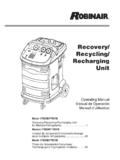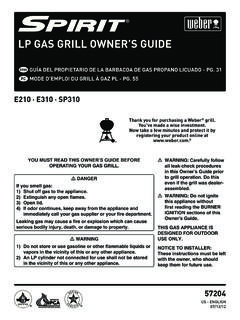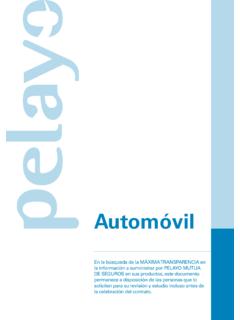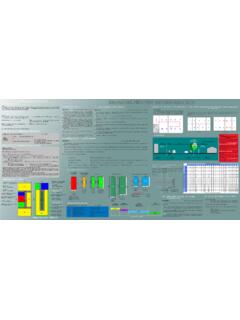Transcription of Ownerʼs Manual Manual del Propietario Guide de l ...
1 TIF RX-1A and XL-1 ARefrigerant Leak DetectorsOwner s ManualManual del PropietarioGuide de l 'utilisateurBedienungsanleitungBOTH MODELS ARE:DESIGN CERTIFIED BY MET LABORATORIES, INC. TO MEET SAE J1627 FOR R134a, R12 AND 1 DI VI SION 2 GROUPS C & D HAZARDOUS LOCATIONS HAND HELD GAS DETECTOR CLAS SI FIED BY UN DER WRIT ERS LAB O RA TO RIES, INC. AS TO FIRE ELECTRICAL SHOCK AND EXPLOSION HAZARDS ONLY. READ OWNERS MAN U AL BE FORE OP ER AT ING. CAU TION: TO REDUCE THE RISK OF ELEC TRIC SHOCK,DE ENERGIZE UNIT BEFORE RE PLAC ING SENSING TIP OR SER VIC ING UNIT, USE ONLY WITH AL KA LINE BATTERIES, SIZE US1 General Description ..2 Features ..2 Parts & Controls ..3 Getting Started ..3 Installing Batteries ..3 Operating Features ..4 Constant Power Indication ..4 Automatic Circuit/Reset ..4 Sensitivity Adjustment ..4 Operating Instructions ..5 Operating Tips ..5 Applications ..7 Maintenance ..7 Replacement Parts ..8 Specifications ..9 Warranty.
2 9 Espa ais ..16 Deutsch ..23 TABLE OF CONTENTSThe TIF RX-1A and XL-1A leak detectors are the culmination of over 30 years of Leak Detector manufacturing experience. TIF is proud to present these tools into which we have incorporated all of our experience, and years of customer feedback, in the hope of providing our valued customers with the best of everything; price, performance and advanced micro-processor is at the heart of each unit. It permits more advanced management of the circuitry and sensing tip signal than ever before possible. Additionally, the number of components used in the circuit is reduced 50%, increasing reliability and efficiency. The micro-processor monitors the sensing tip and battery voltage levels 4000 times per second, compensating for even the most minor fluctua-tions in signal. This translates into a stable and dependable tool in almost any features have been added to enhance usability. A revolutionary new case design gives the user grip and control, and places the visual indicators (RX-1A only) in direct sight during take a few moments to read through the following pages, in order to under-stand and benefit from all the capabilities of your new RX-1A or XL-1A.
3 We trust that you will be 100% satisfied with your new purchase. If you have any questions or com-ments after reviewing the Manual , please feel free to contact us in the USA, toll free at (800) 327-5060 from 8AM to 5PM Models Feature: Microprocessor controlled circuit with Advanced Digital Signal Processing Detect ALL Halogenated refrigerants Certified to SAE J1627 for R12, R22 & R134a Variable frequency audible alarm Constant Power Indication Cordless and portable, operate on 2 C-cell batteries 14" ( ) flexible stainless probe Spare sensing tip included UL Classified for Intrinsic Safety CE Approved Carrying case included Optional reference leak source Two Year WarrantyAdditional Features of TIF XL-1A Single switch controlAdditional Features of TIF RX-1A Six segment visual leak size indicator True mechanical pump provides positive airflow through sensing tip High and Low sensitivity levels One touch reset Tactile keypad controls Real time sensitivity adjustment2 GENERAL INFORMATIONFEATURESI nstalling Batteries1.
4 Remove the battery compartment door located on the bottom of the instrument as shown above. Install batteries, Positive Polarity inwards (towards the unit). (See figure 2).GETTING STARTEDPARTS & CONTROLS1 Sensing Tip2 Tip Protector3 Flexible Probe4 Constant Power Indicator5 Power On/Off6 LED Leak Indicators (RX-1A only)7 Reset Button (RX-1A Only)8 High Sensitivity (RX-1A Only)9 Low Sensitivity (RX-1A Only) FEATURESC onstant Power IndicationThe Constant Power indicator allows the user to see the battery level at all times. TIF XL-1A - The Red LED will remain on whenever the unit is powered on. If the LED is dim, or is not lit, this is an indication that the batteries should be replaced. TIF RX-1A - The first LED (leftmost) in the bargraph will remain on whenever the unit is powered on. If the LED is dim, or is not lit, this is an indication that the batteries should be Circuit/Reset FeatureBoth detectors feature an Automatic circuit that sets the unit to ignore ambient con-centrations of refrigerant.
5 The RX-1A additionally features a Resetfunction key for convenience. Automatic Circuit - Upon initial power on, the unit automatically sets itself to ignore the level of refrigerant present at the tip. Only a level, or concentration, greater than this will cause an alarm. CAUTION: Be aware that this feature will cause the unit to ignore any refrigerant present at turn on. In other words, with the unit off if you place the tip up to a known leak and switch the unit on, no leak will be indicated! Reset Feature - Resetting the unit during operation performs a similar function, it programs the circuit to ignore the level of refrigerant present at the tip. This allows the user to 'home-in' on the source of the leak (higher concentration). Similarly, the unit can be moved to fresh air and reset for maximum sensitivity. Resetting the unit with no refrigerant present (fresh air) causes any level above zero to be Reset the unit:XL-1A - Switch the unit OFF and back ON againRX-1A - Press the RESET key.
6 Whenever the unit is reset, all LED's will light for 1 second. This provides a visual confirmation of the reset Adjustment (RX-1A Only)The TIF RX-1A provides two levels of sensitivity. The base beeping tone is anindication of sensitivity level; the quicker beep rate indicates a higher level. When the unit is switched on, it is set to the high sensitivity To change the sensitivity, press the LO key. When the key is pressed, the visual display will momentarily show the four left LED's red. The base beep rate will slow, indicating Low Sensitivity To switch back to High Sensitivity, press the HI key. The three right LED's will light momentarily, and the base beep rate INSTRUCTIONSOPERATING TIPS1. Switch the unit on XL-1A - Move the ON/OFF switch to the ON position. RX-1A - Press the "I/O" (Red and Green) key. All LED's will light for two sec-onds as the unit performs a self The unit will begin beeping at a steady Verify the battery level by observing the constant power indicator (see above).
7 4. Begin searching for leaks. When refrigerant is detected, the audible tone will change to a 'siren' type sound, distinctly different from the base beep rate. RX-1A - Additionally, the visual indicators will light progressively as described in the Alarm Indications RX-1A - Sensitivity can be adjusted at any time during operation by using the HI or LO If a full alarm occurs before the leak is pinpointed, RESET the unit as described above, to reset the circuit to a zero following section includes several general operating tips, and the SAE J1628 recommended procedure for leak In areas that are heavily contaminated with gas, the unit may be reset to block out ambient concentrations of gas. The probe should not be moved while the unit is being reset. The unit can be reset as many times as In windy areas, even a large leak can be difficult to find. Under these conditions, it is best to shield the potential leak Be aware that the detector may alarm if the sensing tip comes in contact with moisture and/or solvents.
8 Therefore, avoid contact with these when leak J1628 Recommended ProcedureNOTE: On Automotive A/C Systems, test with the engine not in The air conditioning or refrigeration system should be charged with sufficient refrigerant to have a gauge pressure of at least 340 kPa (50 psi) when not in operation. At temperatures below 15 C (59 F) leaks may not be measurable, since this pressure may not be Take care not to contaminate the detector probe tip if the part being tested is contaminated. If the part is particularly dirty, or condensate (moisture) is present it should be wiped off with a dry shop towel or blown off with shop air. No clean-ers or solvents should be used, since the detector may be sensitive to their Visually trace the entire refrigerant system, and look for signs of air conditioning lubricant leakage, damage, and corrosion on all lines, hoses, and components. Each questionable area should be carefully checked with the detector probe, as well as all fittings, hose to line couplings, refrigerant controls, service ports with caps in place, brazed or welded areas, and areas around attachment points and hold-downs on lines and Always follow the refrigerant system around in a continuous path so that no areas of potential leaks are missed.
9 If a leak is found, always continue to test the remainder of the At each area checked, the probe should be moved around the location, at a rate no more than 25 to 50 mm/second (1-2 in/second), and no more than 5 mm (1/4 in) from the surface, completely around the position. Slower and closer move-ment of the probe greatly improves the likelihood of finding a leak (see Fig. 3, below). Any increase in beep rate is indicative of a An apparent leak shall be verified at least once as follows: a) Blow shop air into the area of the suspected leak, if necessary, and repeat the check of the area. In cases of very large leaks, blowing out the area with shop air often helps locate the exact position of the leak. b) First move the probe to fresh air and reset. Then hold the probe tip as close as possible to the indicated leak source and slowly move around it until the leak is A/C Systems only -7. Leak testing of the evaporator core while in the air conditioning module shall be accomplished by turning the air conditioning blower on high for a period of 15 seconds minimum, shutting it off, then waiting for the refrigerant to accumulate in the case for 10 minutes.
10 After such time, insert the leak detector probe into the blower resistor block or condensate drain hole, if no water is present, or into the closest opening in the heating/ventilation/air conditioning case to the evaporator, such as the heater duct or a vent duct. If the detector alarms, a leak apparently has been Systems -8. Following any service to the refrigerant system and any other service which dis-turbs the refrigerant system, a leak test of the repair and of the service ports of the refrigerant system should be TIPSFig. 3 Both of the Leak Detectors covered by this Manual may be used to: Detect refrigerant gas leaks in Air Conditioning or Refrigeration systems and storage/recover containers. These detectors will respond to ALL halogenated (contains Chlorine or Fluorine) refrigerants. This includes, but is not limited to: CFCs R12,R11,R500,R503 HCFCs R22,R123,R124,R502 HFCs R134a, R404a, R125 Blends such as AZ-50, HP62, MP39, R410a Detect Ethylene Oxide gas leaks in hospital sterilizing equipment (detects halo-genated propellant) Detect SF-6 in high voltage circuit breakers Detect most gases that contain Chlorine, Fluorine and Bromine (halogen gases) Detect cleaning agents used in dry cleaning applications such as perchloroethylene.















